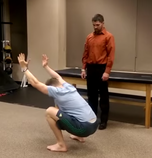- Home
- About Us
- TSPT Academy
- Online Courses
-
Resources
- Newsletter
- Business Minded Sports Physio Podcast
- Day in the Life of a Sports PT
- Residency Corner
-
Special Tests
>
-
Cervical Spine
>
- Alar Ligament Test
- Bakody's Sign
- Cervical Distraction Test
- Cervical Rotation Lateral Flexion Test
- Craniocervical Flexion Test (CCFT)
- Deep Neck Flexor Endurance Test
- Posterior-Anterior Segmental Mobility
- Segmental Mobility
- Sharp-Purser Test
- Spurling's Maneuver
- Transverse Ligament Test
- ULNT - Median
- ULNT - Radial
- ULNT - Ulnar
- Vertebral Artery Test
- Thoracic Spine >
-
Lumbar Spine/Sacroiliac Joint
>
- Active Sit-Up Test
- Alternate Gillet Test
- Crossed Straight Leg Raise Test
- Extensor Endurance Test
- FABER Test
- Fortin's Sign
- Gaenslen Test
- Gillet Test
- Gower's Sign
- Lumbar Quadrant Test
- POSH Test
- Posteroanterior Mobility
- Prone Knee Bend Test
- Prone Instability Test
- Resisted Abduction Test
- Sacral Clearing Test
- Seated Forward Flexion Test
- SIJ Compression/Distraction Test
- Slump Test
- Sphinx Test
- Spine Rotators & Multifidus Test
- Squish Test
- Standing Forward Flexion Test
- Straight Leg Raise Test
- Supine to Long Sit Test
-
Shoulder
>
- Active Compression Test
- Anterior Apprehension
- Biceps Load Test II
- Drop Arm Sign
- External Rotation Lag Sign
- Hawkins-Kennedy Impingement Sign
- Horizontal Adduction Test
- Internal Rotation Lag Sign
- Jobe Test
- Ludington's Test
- Neer Test
- Painful Arc Sign
- Pronated Load Test
- Resisted Supination External Rotation Test
- Speed's Test
- Posterior Apprehension
- Sulcus Sign
- Thoracic Outlet Tests >
- Yergason's Test
- Elbow >
- Wrist/Hand >
- Hip >
- Knee >
- Foot/Ankle >
-
Cervical Spine
>
- I want Financial Freedom
- I want Professional Growth
- I want Clinical Mastery
|
I rarely give patients pathoanatomical diagnosis anymore, but rather I give them a Physical Therapy diagnosis. For example, I do not tell my patients they have a rotator cuff tear. Instead I choose to say they have scapular downward rotation syndrome. This diagnostic approach focuses on a movement based problem and not a single tissue. When looking at movement dysfunction, I choose to focus my attention on the joint level first. Many times I tell my patients they have a joint dysfunction that is limiting their movement. However, unless the patient has had some advanced anatomy course, I have to explain to the patient what joint dysfunction means. More importantly I need to teach them why the joint is affecting their movement dysfunction. In this post I am going to breakdown the definition of a joint dysfunction and the different causes of a joint dysfunction.  The Basics All synovial joints have involuntary movement known as joint play. Generally, the amount of joint play is minimal (<1/8 inch). While this movement is minimal, the joint cannot move normally unless the joint play is normal. If joint play is lost, a joint dysfunction is the result. Since the muscles cannot correct a joint dysfunction, restoring the joint play through mobility based interventions is essential. Why do joint dysfunctions occur? The 4 common causes of joint dysfunction are trauma, immobilization, sustained postures, and following a serious pathology. These 4 causes should seem reasonable. If a patient has a traumatic injury, swelling occurs in the joint altering the normal arthrokinematics. If a patient is immobilized after an injury OR performs sustained postures for several hours at a time, synovial fluid exchange is altered and the joint becomes stiff. Finally if the patient has a more serious pathology, such as a heart attack, their body becomes deconditioned and less mobile. Treatment When one finds a hypomobile joint dysfunction, perform joint mobilizations or manipulation. One's manual therapy skills can drastically assist in returning normal joint play. Following manual techniques, perform a corrective exercise to sustain the changes of the manual techniques. For the patient's home program, give them a similar mobility based exercise so the changes are not lost within session. For example, if a patient presents with scapular downward rotation syndrome. I would assess the thoracic spine and CT junction joint play. Assuming it is hypomobile, I would manipulate these regions. Next, I would perform a thoracic mobility exercise (such as cat/camel or quadruped thoracic extension rotation). Finally, I would give the patient this same exercise at home to sustain the changes gained in the clinic. Let me know if you have other questions regarding joint dysfunctions. Jim
1 Comment
Ned
9/9/2015 06:36:31 am
Hi Jim,
Reply
Leave a Reply. |
Dr. Brian Schwabe's NEW Book in partner with PaleoHacks!
Learn residency-level content on our
Insider Access pages We value quality PT education & CEU's. Click the MedBridge logo below for TSPT savings!Archives
July 2019
Categories
All
|






 RSS Feed
RSS Feed